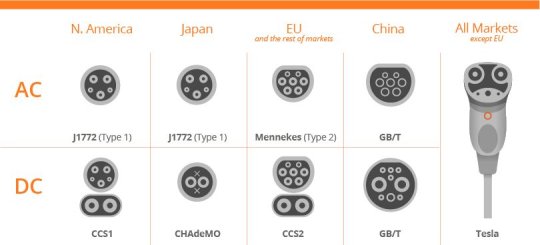Car plug for AC Charging
Plug type: type 1 (Yazaki)
This type was the first. It has been developed for the electricity network of Japan and US. The base voltage there is 120V. 240 Volt is offered as two phases (2 x 120V with a phase rotation of 180*). The charging capacity is then a maximum of 3.7 kWh.
Electric cars suitable for Type 1 cables: Audi A3 e-tron, Cadillac ELR, Chevrolet Spark EV, Chevrolet Volt, Citroen C-Zero, Ford Focus Electric, Honda Jazz EV, Mini Mine E, Mitsubishi iMiEV, Mitsubishi Outlander PHEV, Nissan Leaf, Nissan E-NV200, Opel Ampera, Peugeot Ion, Peugeot Partner Electric, Renault Twizy, Renault Fluence Z.E., Renault Kangoo Z.E., Toyota Prius Plug-in and Volvo C30 Drive Electric.
Plug type: type 2 (Mennekes)
Most houses in European countries are equipped with 3 phases. In the Netherlands, every household has a cable with three phases in the meter box. Of these, only one phase is often used. A plug with three phases is the obvious choice because – with the same amperage – charging can be done twice as fast. The type 2 plug for Europe has been developed from these thoughts. The charging capacity is then 3.7 and 7.4 kWh, depending on 1 or 2 phase at 16 amps. Smart Charging can be used to charge above 7.4 kWh provided that no other electrical appliances are switched on.
The European variant comes with an electronic theft protection. In Europe, the cable is the property of the car owner and can therefore be disconnected from the charging station. The electronic security helps to prevent theft of the charging cable.
Electric cars suitable for Type 2 cables: BMW i8, BMW i3, BYD E6, Mercedes-Benz A-Class E-cell, Mercedes-Benz SLS AMG Electric Drive, Mercedes-Benz B Class Electric Drive, Mercedes-Benz Vito E -Cell, Porsche Panamera S E-Hybrid, Porsche 918 Spyder, Renault Zoe, Smart Fortwo Electric Drive, Tesla Model S, Volkswagen E-up, Volkswagen e-Golf, Volvo v60 Plug-in Hybrid.
Plug type: type 3 (Le Grand)
There is also a type 3 plug developed by 'the EV plug Alliance'. The main difference with the type 2 is a cover for the contacts. This type is mainly found in Italy and France. Due to legislation, all type 3 connections must be replaced by a type 2 by 2017.
Plug type: Combo
With this plug you can charge normally as well as fast charging. This plug will become the standard in 2017. For the time being, AC (Type 2 Mennekes) and CCS (DC Combo) can be charged quickly with this plug.
Electric cars that are suitable for the Combo plug: BMW i3, Volkswagen e-Golf, Chevrolet Spark EV, Volkswagen e-Up.
Car plug for AC Fast charging
Some cars can charge fast. Cars that can charge fast are for example; The Nissan Leaf, the Peugeot iOn, Citroen C-zero, and the Mitsubishi Outlander. In the Netherlands you can quickly charge with the following plugs:
Plug type: CHADeMo
With the CHADeMO plug you can charge quickly in the Netherlands. With this plug, up to 50 kW direct current can be charged at fast charging stations. At a fast charging station, a cable hangs from the charging station. Read more about fast charging here.
The following car brands are suitable for fast charging ChaDeMo: Nissan Leaf, Nissan e-NV200 (Evalia), Mitsubishi Outlander PHEV, Peugeot iOn, Citroen C-Zero and KIA Soul EV.
Plug Type: CCS (DC Combo)
You can charge quickly with the CSS (DC Combo) plug. With this plug, up to 50 kW direct current can be charged at fast charging stations. At a fast charging station, a cable hangs from the charging station. Read more about fast charging here.
Electric cars suitable for fast charging CSS (DC COMBO): BMW i3, Volkswagen e-Golf, Chevrolet Spark EV, Volkswagen e-Up.
Safety charging point and charging cable
There are few risks when using a charging station. Voltage is only applied to a charging station once an electric car is connected. Compared to a socket, nothing happens when you plug something into the socket. Also, no sparks can occur when the cable is pulled out. Of course, someone could trip over the cord, so pay attention to how you lay the cord.


